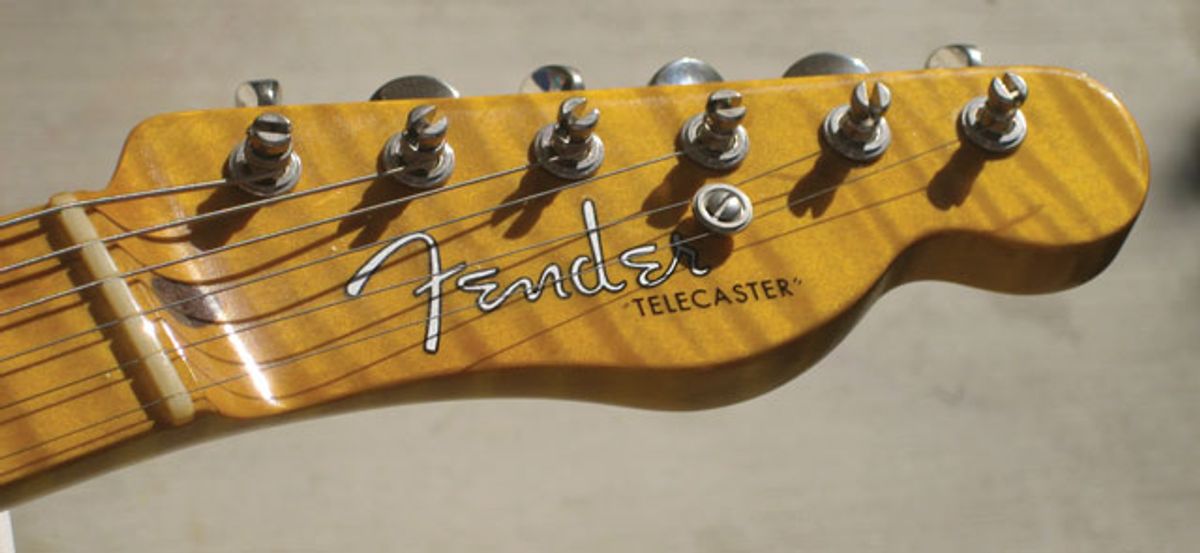
You’d be surprised how many possibilities you have even with a single-pickup Esquire!
For many, the Telecaster remains the quintessential electric guitar. Despite
its simplicity, the Tele offers a wide range of modding possibilities.
If you read Mod Garage with any regularity, you'll know we've been covering Stratocaster mods for several years now. During this time, I've received countless e-mails about Telecaster mods, so I know a lot of you are waiting for this. Well, now the time has come! Fans of this iconic guitar will be happy to know that with this month's column, we begin a series of Tele and Esquire mods.
On a personal note, I enjoy playing a good Strat, but the Telecaster is still my weapon of choice. It was the first real electric guitar I owned and it fits my playing style perfectly. I love its tone, shape, and the simplicity of the whole structure, and, of course, knowing it was the first real electric guitar from Leo Fender—a piece of history.
Many people assume that because a standard Tele sports only two pickups, two controls, and a 3-way pickup selector switch, there isn't much to mod. But you'd be surprised how many possibilities you have even with a single-pickup Esquire!
Let's start with a brief discussion about the Telecaster's essential construction, and discover how to do some simple modifications to it to enhance its fundamental tone. Then we'll ease into some very basic—but supereffective— modifications, just to warm you up for what will follow. I've received a lot of emails about this subject, and I've made a list of the most-requested mods. Each month we'll explore a new one, and gradually our projects will get more complex.
But before we heat up the soldering iron, let's take a moment to think a little about physical construction and discuss ways to enhance the primary tone of your Telecaster. This is an often underrated and overlooked subject for electric guitars. Many people think it's only the pickups that make the difference, but a pickup by itself is a really “stupid" device—it can only sense the vibrations coming from the guitar and transport that signal to a stompbox or amplifier.
Our acoustic colleagues know what I'm talking about because primary tone is what it's all about for them. So it's time to face the facts: On an electric guitar, “good" or ““bad" sound is directly linked to its primary tonal characteristics.
In simple terms, the primary tone of any electric guitar is what you hear when you play it unplugged. Besides this, you can also feel the primary tone, because the whole guitar vibrates and resonates. Depending on the spot you touch, you'll feel different vibrations. Give it a try. Touch the neck, the body, the bridge, and the headstock, while someone else is playing your guitar.
There are many simple things you can do to enhance your guitar's primary tone. In some cases, these can make an average guitar sound good, and sometimes they'll even make a good guitar sound fantastic.
So let's get busy.
Screws. Regularly check all the screws on your guitar. They should be very tightly fastened for structural integrity and a better sound, but don't break them! Critical locations are the screws that attach the neck, the bridge, and the tuners. Loose screws can also be the source of persistent rattling noises that sometimes are even audible when playing through an amp.
And remember: Flat screwdrivers are not designed for Phillips screws and vice versa! Get a good quality set of screwdrivers for this work, otherwise chances are good that you will mar the screws. When you don't use a particular tool very often, it can make sense to buy a budget-quality item, but screwdrivers are definitely the wrong place to save money. There are specialized screwdriver sets for luthiers and guitar techs that are perfect for this work. For years I've used a set from stewmac. com, and to this day they've never let me down.
Neck pocket. Take care of your neck cavity. Remove the neck and check the cavity—it should be absolutely free of any paint, dirt, and other things. During the years I found a lot of funny things in there—credit cards, paper, cardboard, and so on. The bottom and the sides of the neck cavity should be absolutely bare and free of any paint. If it's not, take a piece of fine sandpaper and rework your cavity until you see the plain wood.
If you feel that the neck does not fit the guitar's cavity because the cavity is too wide or too low, get your guitar to an experienced luthier who will shim it. Bad work at this critical point can ruin your guitar's tone! If you find a very thin piece of wood or wooden veneer inside the cavity, then it has already been shimmed at the factory for some reason. In this case, leave the shim and cavity untouched, and get the guitar to your local luthier or guitar tech. He will check the neck angle for you and, if necessary, correct it.
Neck heel. Check the neck heel—this is what attaches to the neck cavity. Often you can find stickers, paint, or bubbled finish there. If so, scrape this away. I also highly recommend you sand away all the paint or finish until you can see and feel the plain wood on the neck heel. You don't need any paint there, and a strong and even “wood-to-wood" connection will enhance the tonal transfer dramatically. As you bolt on the neck, set the screws very tight, but don't overdo it— beyond tight, there is broken.
Let it breathe. Your guitar needs to “breathe," or resonate. To accomplish this, remove the paint at any location that can't be seen. On a Telecaster, a critical location is the surface underneath the bridge. Many professional guitar techs remove the paint between the bridge and the body to give the hardware direct contact to the wood. This will enhance tone on most guitars.
Some professional techs also remove the paint inside the pickup cavities and anywhere the pickguard covers the body. Though some players swear by this, personally I would not do this to any guitar—not my own nor my customer's.
Next issue, I'll be back with another round of tone tips for Teles. Until then, happy modding!
Dirk Wacker lives in
Germany and is fascinated
by anything related to old
Fender guitars and amps.
He plays country, rockabilly,
and surf music in two
bands, works regularly as a
session musician for a local studio, and writes
for several guitar mags. He's also a hardcore
guitar and amp DIY-er who runs an extensive
website—singlecoil.com—on the subject.


